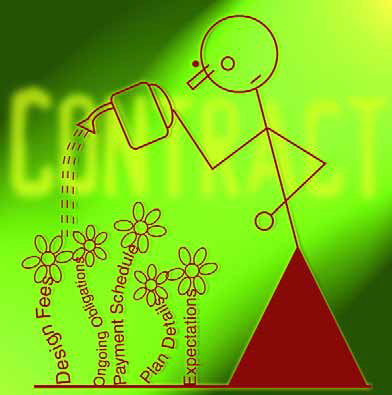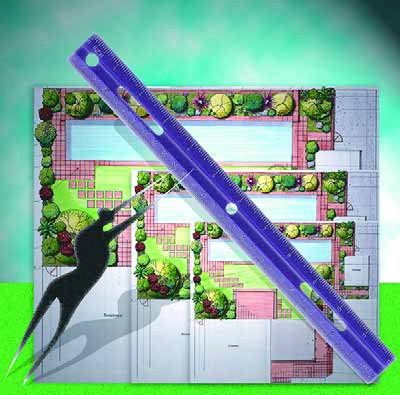installation
When we think about the challenge of literally "shaping" a body of water, we must start by thinking about edges. The edge is the pond's DNA or blueprint. It tells us almost everything about the pond. Without being able to observe the edge, you can't discern whether it's a formal pond, lake or a sewage-treatment facility. It might be a beautiful water feature or an eyesore. The edges form our reference in defining the whole setting and are consequently of the utmost importance. We find this defining-edge concept at work in nature's own beaches, riverbanks and lakeshores, and it is a one that extends right through the heart of watergardening and all types of watershaping, whether architectural or naturalistic (or, as I commonly classify them, formal or informal). No matter the focus or intent of our designs, we must always consider what will be happening at the water's edge. This is the part that demands the most thought, skill, care and expenditure. The subject of edges is so massive that it will be considered here and in articles to come. For purposes of this discussion, we'll limit our look to the use of edges in informal pond settings and situations in which we are attempting to create the impression that the body of water in question was originally
Successful residential exterior design is akin to a precisely choreographed dance. One sequence of steps defines the relationships among hardscape, water and plants. Other sequences distinguish light and shadow, color and texture, open views and intimate spaces. If the choreographer has done a good job, we don't see the individual steps so much as we enjoy the overall experience of motion. The key to making these multifarious steps work together? It's all about balance. Transferring these principles to backyard design, there's a similar need for
It'd be great if we all lived in a world where a handshake was sufficient to seal a deal and no legal documents were needed. Unfortunately, however, we live in a society in which contracts are a necessity for most of us in business. When I first started out, I took on jobs without signed contracts, and for the first few years I didn't run into any problems. As I moved into higher-dollar projects, however, I developed a quick appreciation for the value of a contract when a client refused to pay for my services as we'd verbally agreed he would. Although I realize there are people out there who run strong, successful businesses without a need for contracts and rarely run into problems, for most of us I believe it is a critical component of every job. The purpose of any contract is to
Most of us are in business to earn a living, which is probably why so many of us think of the high-end market as the place to be. In general, of course, the bigger the job, the larger the paycheck will be. But when I look more closely at the work I've done through my career, I believe we might be overlooking valuable opportunities for personal and professional growth by being so single-minded in pursuing grand, big-ticket jobs. When I started my business 15 years ago, I was happy to find work on small borders in small spaces. Since then, I'm proud of the fact that I have worked my way up to designing for multiple-acre estates. To be sure, I much prefer having a few large jobs to a bunch of smaller ones, but
The Chicago Botanic Garden is located, oddly enough, a good 40 miles from that city in the suburb of Glencoe, Ill. And although it is specifically named for the Midwest’s greatest city and might seem a municipal endeavor, it is actually maintained by private donations and serves to display the entire region’s rich flora and scenic beauty. The garden is organized around a large body of water known as the Great Basin, which was created some 60 years ago by dredging the area and diverting the Skokie River to create a series of islands and lagoons. The largest island, known as Evening Island, was the initial focus of our work in redesigning the space. My firm, Oehme, van Sweden and Associates of Washington, D.C., became involved in the project
Our projects generally take two forms. On the one hand, we're called upon to "heal" ailing bodies of water that have been set up with inadequate or improperly functioning circulation and filtration systems. Although other people's mistakes mean good business for us, I won't say that we ever look forward to seeing potentially beautiful ponds or lakes cursed by unappealing or even unhealthy water conditions. On the other hand, we often have the opportunity to join a project at the design phase and handle the installation as well, applying what we know about water quality from the first conceptualization of the watershape. That's always a welcome prospect: Not only is it exciting to
For many of us in the watershaping business, the design and creation of fountains and water displays follows a predictable set of functional patterns. Given the traditional tools of the trade and our repertoire of nozzles and spray apparatus, for example, we tend to fashion effects and shapes from the ground up, literally throwing water in the air in a more or less uncontrolled manner. From a design standpoint, the problem with this tradition is that it eats up space like nobody's business: The pools needed to catch free-falling flows of any noteworthy height need to be large enough to capture water subject to the effects of splash, wind drift and overspray. The higher the spray, the larger must be the footprint of the pool to contain it adequately. As a rule, these pools need to have diameters of twice the height of the spray - by any measure a significant contribution of expensive commercial real estate to the creative effort at a time when property owners are motivated to make every available square foot an income producer. As an alternative in this space race, watershapers have found dry-deck or curbless fountains to be a great way to
When you execute complex projects for sophisticated clients, your ability to satisfy them and their tastes by bringing something different or interesting or unique to the table can make all the difference. As our firm has evolved, we've increasingly come to focus on identifying these compelling touches, which for us most often center on old-world influences that resonate, sometimes deeply, with our clients. I've always loved to travel and have spent extended periods in Asia, Latin America and Europe. At some point, it occurred to me that by working not only with the principles of classical European and Asian garden design, but also with authentic, imported materials and art objects, the work would take on greater meaning and interest for me - and for my clients as well. To that point, our firm had followed a path of influence that still reflects itself in our replication of ancient stone-setting techniques. While traveling in China and Japan, I began spotting stone pieces and other objects we could use directly in our watershapes and gardens and started acquiring pieces for that purpose. This step beyond evoking not only the style but actually using elements of authentic design quickly turned into a powerful element in our work. As we moved further in this direction, the channels opened wider, the creative possibilities blossomed and we soon began incorporating more and more of the materials and ideas that I'd encountered
I've always been fascinated by the concept of urbanism as defined by Thomas Jefferson: He boiled it down to the notion that everyone should have his or her own private space as well as a buffer against the outside world. In a sense, the physical concept of the front yard fits perfectly within Jefferson's utopian ideal. At root, it's an ingenious setup that has probably endured for so many centuries because, on some level, it addresses our primal need to have land all around us. By the very configuration of our residential spaces, we each have a small, open, pastoral area that separates the privacy and sanctity of the home from adjacent public areas, sidewalks and streets. The problem is that in many modern cities and suburbs, the amount of room allocated for front yards in particular has dwindled as property values have soared and lots have become smaller and more tightly packed as a result. And when you combine that spatial shrinkage with the increased desire for safety and privacy on the part of many homeowners, it all works together to place ever-higher premiums on how we choose to make use of our small slices of front-yard land. To my mind, this dynamic set of trends






















